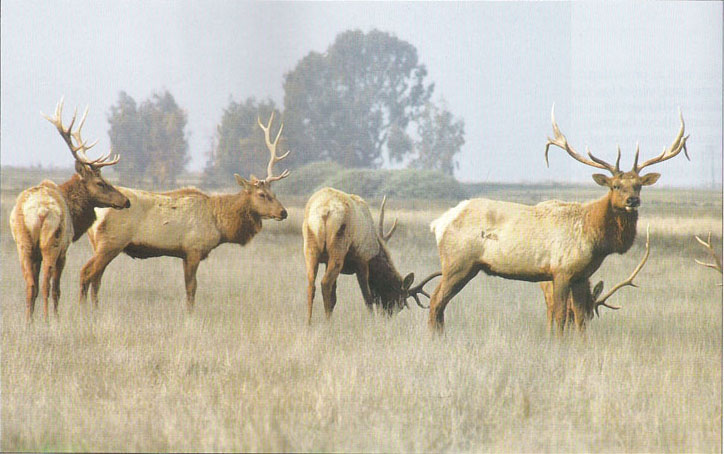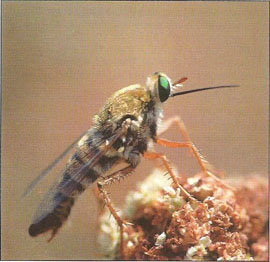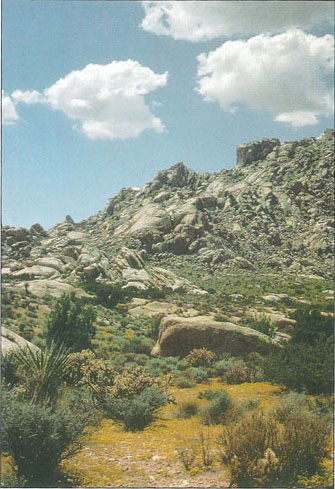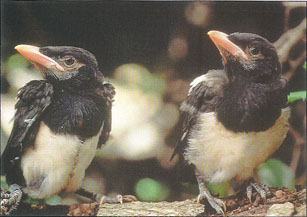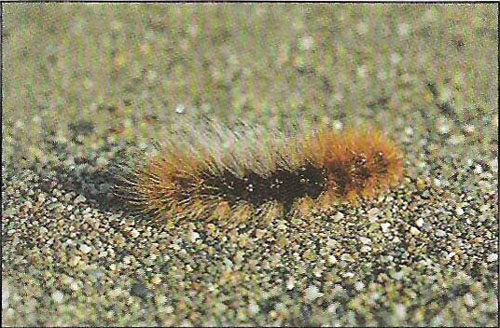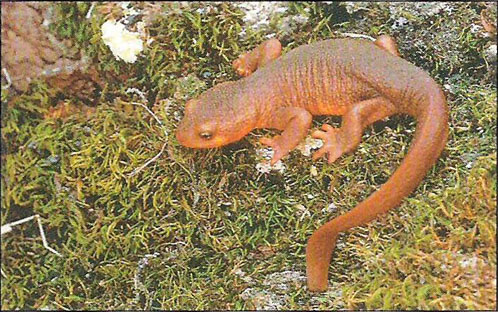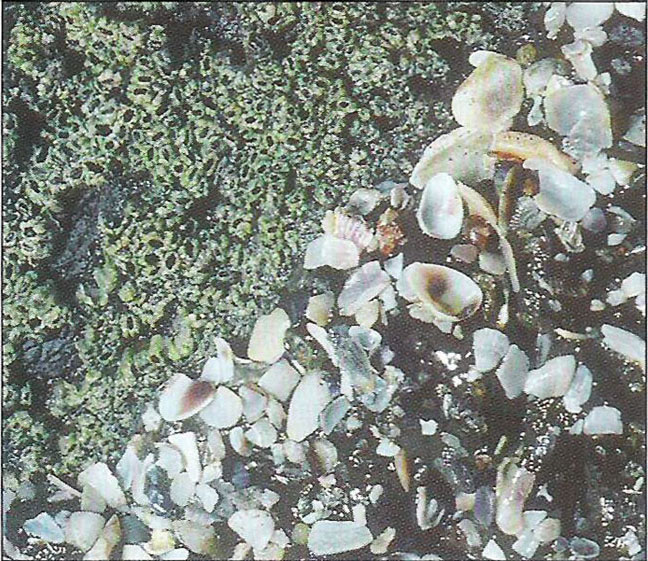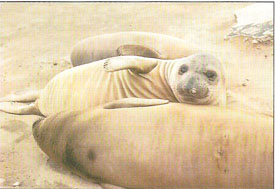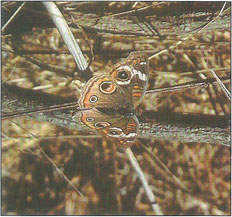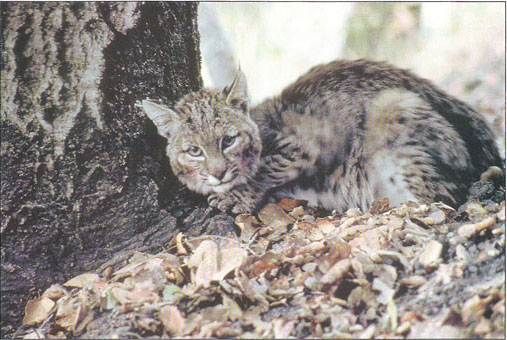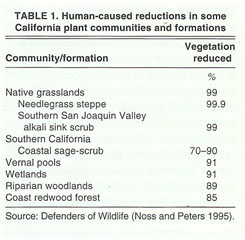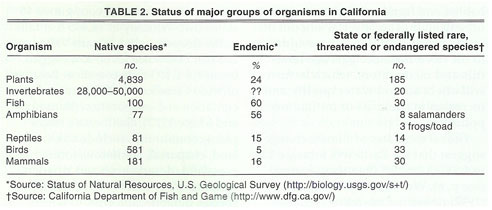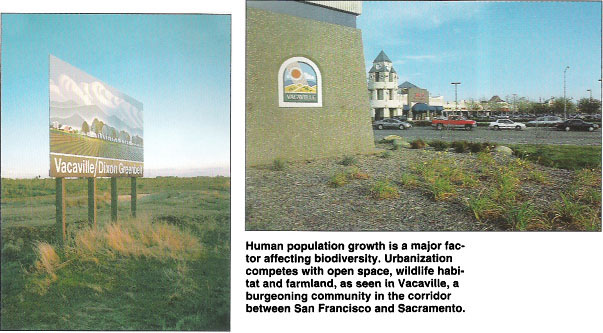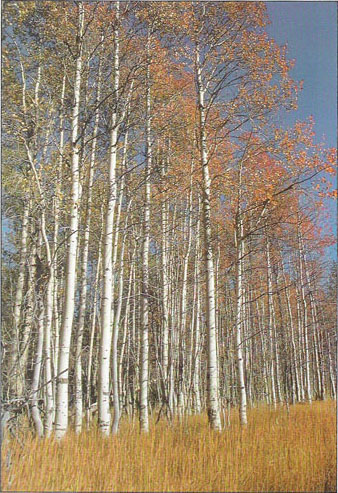All Issues
Biodiversity is critical to future health of California's ecology and economy
Publication Information
California Agriculture 54(2):26-34. https://doi.org/10.3733/ca.v054n02p26
Published March 01, 2000
PDF | Citation | Permissions
Abstract
Each individual organism plays a role in the birth-to-death cycle of this planet. Ecologists often refer to the web of life, describing the interconnectedness of all organisms and environments. Of California's more than 4,800 native plant species, 29% are only found here. Each species is the repository of an immense amount of genetic information. Organisms provide direct economic value to humans in the form of marketable products such as food and medicine, as well as services like recreation, beauty and clean water. But civilization has been altering the Earth's environment and the composition of its species, and consuming resources at rates faster than during any known era in history. At the same time, we are poorly equipped to evaluate the environmental and economic trade-offs between species as traditional commodities, as providers of ecosystem services and as players with largely unknown roles in life on Earth. New institutional frameworks and incentives must be developed in the 21st century for making informed and wise choices about the environment. Such decision-making frameworks should ensure the protection of fundamental sources of food, clean water and habitat that are Earth's life-support system.
Full text
The diversity of life is the greatest source of wonder on this planet. It is difficult to determine how many distinct species there are, but best estimates vary between 5 million and 30 million. Life varies from the smallest virus or single-cell bacterium to better-known multicelled species like spiders, rabbits and elephants. Each individual organism leaves a trace in its environment as it grows, lives, dies and decomposes. As it lives, the organism utilizes resources from the earth, and when it dies and decomposes it returns nutrients back to the earth.
Each individual has a role in the birth-to-death cycle, providing food for others as primary producers, eating others as consumers, or breaking down the dead to return nutrients to soil and water for use by microbes and plants. Ecologists often describe this process as the “web of life,” the interconnectedness of all organisms and environments on Earth.
Each group of organisms, and richness of diversity itself, also plays a role in ecosystem services — the conditions and processes through which natural ecosystems, sustain and fulfill human life (Daily 1997). Examples of ecosystem services provided by living organisms include cleansing of water and air, formation and protection of soils, production of food, fiber, medicinals and pest control. Biodiversity is directly linked to the quality of life we have come to expect.
Biodiversity occurs at all levels of organization, from genetic variation within and among species to variation within and among habitats (Tilman 1997). Biodiversity is the product of evolution working through natural selection to confer reproductive success to the gene combinations (species) that are best adapted to the environment.
Each species, including human, is the repository for an immense amount of genetic information. The number of genes ranges from about 1,000 in a bacterium and 10,000 in some fungi to 400,000 or more in many flowering plants and a few animals (Wilson 1988). The typical mammal, such as a house mouse, has about 100,000 genes. Humans have genetic information closer in quantity to the mouse than to the more abundantly endowed salamanders and flowering plants; the difference, of course, lies in what is encoded.
Of 4,839 native plant species in California, 185 are considered rare, threatened or endangered. At the UC Natural Reserve System's Sweeney Granite Mountains Desert Research Center in the Mojave, yellow chinchweed (Pectis papposa) covers the ground at summer's end.
A comprehensive, recently released study by the Nature Conservancy found that the United States has more than 200,000 native species, at least twice as many as scientists had previously thought (Stein et al. 2000). However, 7 % were found to be critically imperiled, 8 % imperiled and 16 % vulnerable. Three of The Nature Conservancy's five “hot spots” — places where high numbers of species found nowhere else are at risk — were in California: the San Francisco Bay Area, Southern California and the Death Valley region. (The others are the southern Appalachians and the Florida Panhandle.)
Why preserve biodiversity?
The arguments for the preservation of biological diversity are well established (Kucera and Barrett 1995; Heywood 1995) while the value a person places on biodiversity may depend on the individual's background, scientific knowledge, or aesthetic, ethical, religious or economic values.
Economic values.
Many attempts have been made to place an economic value on species in order to justify their conservation. In particular, government policies are largely driven by economics (Kunin and Lawton 1996; Begon et al. 1996). The direct-economic-benefit argument has been largely successful, but only for the conservation of a few species. For example, relatively few species — perhaps 3,000 plants — have significant histories of human utilization, with about 30 of those currently supplying the vast majority of our food and economic value (Kunin and Lawton 1996). Similarly, a relatively small number of animals have been utilized directly for food, or sold for other products. Ironically, many economically useful animals — such as sea turtles and whales — have been harvested in an unsustainable manner and are now extinct or endangered.
Recreation.
Organisms provide indirect economic value to human beings in the form of services such as recreational viewing, which do not require the consumption of the resource. In fact, recreational use, wildlife viewing, nature-based tourism (such as “ecotourism”) may far exceed consumptive-use values. (Goulder and Kennedy 1997). The problem is that while people are willing to pay for these amenities, it is difficult to develop either political consensus or market mechanism to satisfy the demand.
Ecotourism is indeed a growing industry at home and abroad. Travel to U.S. National Parks Service areas generated direct and indirect economic impacts for local communities of an estimated $14.2 billion and supported almost 300,000 tourist-related jobs during 1996. Likewise, the World Tourism Organization estimates that nature-based tourism generates 7% of all international travel expenditures (Ecotourism Society 1998).
Ecosystem services.
Biodiversity provides a variety of ecosystem services, such as pollination, nutrient cycling and cleansing of air and water. Organisms are our thermometer for judging the health and sustainability of earth as a system. Where biodiversity is lost, system processes decline. For example, Tilman and Downing (1994) found that species-rich plots declined in productivity by one-half of predrought levels, while species-poor plot productivity declined to one-twelfth of predrought levels in Minnesota grasslands. The worldwide decline in amphibian numbers and widespread deformities in frogs may indicate severe distress in aquatic ecosystems. The concept of ecosystem services has become relevant to the national political debate and legislation such as the Endangered Species Act.
Moral and ethical responsibilities.
Many of the world's religions now teach that human beings have a moral and ethical responsibility to care for life on Earth.
Current extinction rates of plants and animals are higher than they have ever been in the fossil record, primarily due to human activities. Heywood (1995) estimates that the current extinction rate is 10 times the background rate. Wilson (1988) estimates current extinction rates at 1,000 to 10,000 times higher. Currently, 480 animal species and 706 plant species are listed as endangered and threatened in the United States (USDI 1999).
This rapid loss of biodiversity presents a new set of urgent challenges to scientists worldwide. In addition to better scientific understanding of ecosystem structure and function, there is a vital need to translate this information to the general public as well as policy-makers in ways that will prompt actions to conserve what remains.
If humans cannot maintain biodiversity in the short term, how will we maintain ourselves and our quality of life in the long term? Such arguments for the preservation of biodiversity are often polarized between enthusiasts devoted to the cause of conservation and those who view the Earth's resources primarily as products for human benefit (Kunin and Lawton 1996). Yet human civilization has never had a more pressing need to understand its dependence on nature as a whole (Reichert 1997). I share with numerous scientists a set of fundamental convictions (Daily 1997; Huston 1996; Heywood 1995), that
-
Civilization is dangerously altering Earth's environment and consuming resources at rates faster than ever before.
-
Society is poorly equipped to evaluate environmental and economic trade-offs between species as traditional commodities, providers of ecosystem services, and players with as-yet unknown roles in life on Earth.
-
New institutional frameworks and incentives must be developed for informed and wise decision-making.
-
Decision-making frameworks must ensure the protection of fundamental sources of food, clean water and habitat.
Ecosystem responses to extinction
Species numbers are directly related to the capacity of an ecosystem to resist as well as rebound from environmental disturbances (Mooney et al. 1995). Theoretically, ecosystem processes may respond in one of three ways to reductions in species.
First, the “redundant species” hypothesis (Walker 1992; Lawton 1994; Lawton and Brown 1993) suggests that a minimal level of diversity is required for proper ecosystem functioning, but beyond that adding or deleting species has no detectable effect. More than one species can play the same role or provide the same service in the functioning of a system, so that if one is lost its “role” will be taken over by another species, but only up to a point.
Contrasting this theory is the “rivet hypothesis” (Ehrlich and Ehrlich 1981), which suggests that all species make a contribution to ecosystem processes. Like the rivets on an airplane wing, redundancy is built in so that the wing doesn't fail. But as rivets fall out, the wing becomes impaired until it eventually fails and the plane — the entire system — crashes.
A third view, the “idiosyncratic response hypothesis,” suggests that the number of species per se is not important to ecosystem functioning, but rather individual species and their characteristics (Lawton 1994; Vitousek and Hooper 1994). Since the roles of individual species are complex and varied, it is difficult to predict ecosystem responses to various kinds of disturbances (Kunin and Lawton 1996).
Ecologists have argued for decades that species are not interchangeable. Harper (1977) and Naeem et al. (1995) presented convincing experimental evidence that this is true. Testing these three hypotheses, using small artificial microcosms in a controlled environmental facility called the “Ecotron,” they found that decomposition rates, water and nutrient retention varied idiosyncratically as species richness varied. However, the uptake of carbon and plant productivity declined with the numbers of species, as predicted by the rivet hypothesis.
This apparently happened because not all ecosystem functions would vary in the same way, and species diversity is only one attribute of the system. Although it is unclear whether these results can be applied to the Earth as a whole, the experiment supports the growing list of reasons for erring on the side of species conservation. We know redundancy exists, but we don't know the amount of redundancy present, or when one more species extirpation is one too many.
Human population growth is a major factor affecting biodiversity. Urbanization competes with open space, wildlife habitat and farmland, as seen in Vacaville, a burgeoning community in the corridor between San Francisco and Sacramento.
Population and global warming
Human population growth and global climate change are major factors affecting biodiversity and the ability of California's natural ecosystems to supply essential services. Fifty million people are expected to live in California by 2025 (Clark 2000). California is not an island; its people will export agricultural products, information, technology and science, and they will import resources. Likewise, more people will demand more resources, food, clean water, wood products, cars, roads, housing, recreational facilities and industry.
The end-result will likely be further reductions in open space, wildlife habitat and farmland and increased urbanization. The physical amount of waste products will grow, resulting in the need for more garbage landfills and incinerators, which in turn will affect air and water quality and increases in the costs of mitigating pollution.
Global estimates of climate change suggest that the Earth will increase 1.5 to 4.5°C (3.2 to 9.5°F) in temperature ( see p. 6 ). Westman and Malanson (1992) presented modeling evidence that California's Mediterranean-like climate will generally increase in temperature. A temperature change of this magnitude is likely to shift vegetation community boundaries and centers of distribution, although the total displacement of any type from its current geographic range is not expected (with the possible exception of subalpine forest-meadow, which has nowhere to go and therefore will be greatly reduced.
Survival of any species depends on pollinators, predators, nutrients and the ability to find mates. In general, human alteration of vegetation patterns, through development, will overshadow the immediate effects of climate change on vegetation movement (Allen-Diaz et al. 1996) (table 1).
Status of California biodiversity
Today, California is a complex of diverse landscapes ranging from the tallest mountain in the contiguous 48 states (Mt. Whitney at 14,445 feet tall) to the deepest valley (Death Valley at 282 feet below sea level) to a rugged, beautiful 1,100-mile coastline. Because of wide variations in temperature, precipitation and evaporation (Barbour and Major 1977), California's major plant communities include oak wood-land, chaparral, coniferous forest, grassland, desert shrub and riparian systems. More than 4,800 native plant species inhabit California, of which about 29% are endemic, found only in California (Wilken 1993). This extraordinary diversity far exceeds that of the rest of the United States, including Hawaii, as well as continental Eurasia, largely because of California's geologic, topographic and climatic diversity.
The diversity of plant communities provides habitat for numerous animal species (table 2). New native species are still being discovered, while habitat change — including urban growth and agriculture, and human resource extraction — are threatening others with extinction.
The most human-altered ecosystems in California, such as the L.A. Basin or the S.F. Bay Area or the Central Valley have been affected by agriculture, urbanization, grazing and timber harvesting. Noss and Peters (1995) report significant reductions in the native vegetation of several California plant communities and formations (table 1). Human activities have also introduced new species to California. The native California grasslands, for example, are now dominated by introduced species of Mediterranean Europe. The Jepson Manual lists 1,023 naturalized alien species (Hickman 1993). Whether these newcomers provide similar ecosystem benefits to people is matter of debate ( see box, p. 32 ). Managed grazing can be compatible and useful in meeting conservation objectives. Urbanization, on the other hand, generally encompasses a complete conversion of land with few accommodations for species or habitats. Agriculture is generally some-where between the two, depending on the agricultural method.
Much of the high-elevation forests in the Sierra Nevada, Cascade Range, Klamath Mountains, the drier Southern California mountain ranges and the southern deserts are sparsely developed and well-represented in the public lands system. About 48% of California is in some form of public ownership: 20.4 million acres are included in the national forest system; the Bureau of Land Management holds another 17.1 million acres; 4.7 million acres are part of the National Park system; 2.8 million acres are used by the U.S. Department of Defense; and another 2.5 million acres fall within the jurisdiction of the State of California (Ewing et al. 1988). Lands considered less economically valuable in the last century have become the relatively unaltered wilderness and natural areas conserved within national parks, national forests and public lands throughout the state.
Why preserve biodiversity? Vernal pools are beautiful, but they also provide ecosystem services such as species habitat, nutrient cycling and cleansing of air and water.
Tools for preservation
The U.S. Environmental Protection Agency celebrated the 25th anniversary of the Endangered Species Act in 1998. This optimistic law confidently and consistently declares that all species are worthy of protection (Butler 1999) and that all creatures should live because life itself is the overwhelming value. Protecting biodiversity is the central theme of the Endangered Species Act.
Nonetheless, it has been a controversial mechanism for conservation of species because of its emphasis on individual and “visible” species. Many view the law as inflexible, unfair to private landowners and unresponsive to social and economic factors. For example, farmers have worried that implementation of ESA would disrupt flows of water in order to protect delta smelt, and reduce agricultural cultivation, which disturbed kangaroo rats (O'Brian 1995). However, Moyle (p. 16) notes that concerns voiced by farmers about delta smelt stealing their water have not been borne out. While it may be folly to risk the extinction of these two species to satisfy needs of people, others argue the needs of people should come first.
Other mechanisms have been proposed for protecting biodiversity. Public entities and private developers have increased their efforts to deal with land-use issues on ecosystem and regional scales, due to growing awareness of the relationship between human population growth, habitat conversion and fragmentation, and the endangerment of species. Most of these proposals allow for resource extraction, or use, while providing mitigation to protect and conserve species. Examples include federal and state habitat conservation plans, the use of zoning laws to limit sprawl, the expansion of parks and wilderness areas, and changes in public-land management agency approaches. Still other proposals recognize the need for conservation beyond species, and focus, in contrast, on the protection of rare plant communities or large blocks of habitat (e.g., California Native Plant Society, The Nature Conservancy).
Furthermore, the interagency California Natural Areas Coordinating Committee divided the state into 11 bioregional planning areas in 1990. The California Biodiversity Council adopted an interagency strategy for conservation of biodiversity in 1991, and the U.S. Forest Service adopted the term “ecosystem management” as a guiding principle in 1996. As Romm states, “Simple choices of 25 to 50 years ago of preservation versus use, public versus private, no longer encompass the interests of California's population” ( see p. 35 ).
Goals of ecosystem management
Ecosystem management is defined as a collaborative process that strives to reconcile the promotion of economic opportunities and livable communities with the conservation of ecological integrity and biodiversity.
The goals of ecosystem management are to (1) maintain a functioning system of ecosystem integrity; (2) sustain biodiversity and ecosystem processes at a regional scale; (3) sustain vibrant, livable and economically diverse human communities; (4) incorporate distinct community and stakeholder values; and (5) integrate the ecological, economic and social goals of stakeholders in an ecosystem (Keystone Center 1996).
Federal land-management agencies and others managing natural resources have expended considerable effort to implement the principles of ecosystem management. However, the current emphasis is still on methods for implementation; scientists and managers don't have the knowledge yet to identify all forms of life, much less predict management effects on these species.
Ecosystem management and ecological sustainability represent a paradigm shift in public-lands management in California. For example, the Sierra Nevada Ecosystem Project (SNEP 1996) is a comprehensive, multimillion-dollar regional assessment of the state's defining mountain range. The Sierra Nevada Framework (SNF 1999) is a bioregional environmental impact statement for the Sierra Nevada to ensure six major resource issues — old growth, riparian, oak woodlands, fire and fuels, noxious weeds and roads — are considered in an integrated fashion using science. Likewise, commodity production on public lands has dropped significantly nationwide, including a 70% reduction in timber harvests (13 billion to 4 billion board feet), 40% decline in oil and gas leasing, and 10% decline in livestock grazing leases (MacCleery 1999).
Are natives best?
California has 4,839 known native plant species of which 1,416 endemic species are found only in California (Hickman 1993). However, 5,862 total plant species are known to occur in California, which means that 1,023 (17.4%) are naturalized aliens. Naturalized aliens are plant species that arrived in California primarily through the activities of humans and now grow, thrive and reproduce in their new habitats.
Some ecologists (Mooney et al. 1995) argue that alien-species introductions, fragmentation and disturbance of ecosystems and landscapes will have profound effects on ecosystem services because these impacts generally shift the balance of species present from large, long-lived species (often natives) to small, short-lived ones (often non-natives). This kind of shift reduces the capacity of systems to sequester carbon, store nutrients, and provide pest protection.
Other ecologists, however, argue that there is great redundancy in ecosystems, with many different species capable of playing the same role. For example, introduced annual grasses may be as efficient at maintaining soil protection and cycling nutrients as native mixes of perennial grasses. Introduced eucalyptus trees transpire, break the force of rain, protect soils, provide wildlife habitat and contribute to the production of fresh water as well, perhaps, as native oaks.
Some invasive or introduced species are probably ecological substitutes for native species, such as Harding grass — an introduced perennial bunchgrass — for the native Leymus triticoides or well-managed cows for native tule elk. Others, like yellow starthistle, or northern pike or the riparian invader Arundo — a large bamboolike plant that is invading many Southern California and Central Valley streams — greatly disrupt ecological functions and ecological services. Our interpretation of the effect of introduced species is clouded by the scale we choose to examine effects. For example, eucalyptus breaks the force of rain, drops leaves, and provides wildlife habitat as do the native oaks, but it is a different habitat, fuel loading and a nutrient cycling system. It may be that most species are redundant from the point of view of ecosystem services, but further research must be conducted on this issue.
— B.A.-D.
According to the Committee of Scientists report (1999) commissioned by U.S. Secretary of Agriculture Dan Glickman, the emphasis for managing what remains on public lands should be ecological sustainability and the protection of biodiversity on moral and ethical grounds. Consequently, commodity production on Forest Service lands in the United States is likely to continue to decline in the future. The Clinton administration is using the report to provide scientific guidance for the management of Forest Service lands.
Human consumption of natural resources continues to have a significant impact on biodiversity. While commodity production on U.S. public land has declined, worldwide demand for resources has not changed and may soon increase. As a nation's economy develops and education improves, its fertility rate will decline; but citizens also develop more purchasing power and may follow the lead of Western consumers. Western nations complain about poor environmental controls in developing nations, but they continue to consume the lion's share of the Earth's resources. This paradox will continue to vex researchers and those working to promote biodiversity.
Future in focus: Critters, conservation and California
If political support continues, many of California's resources will be protected in preserves, parks, conservation easements, natural areas and other limited-use forms. Federal, state and local regulations or ordinances restricting the use of pesticides, timber harvesting and livestock grazing will continue on both public and private lands. At the same time, California's population will continue to grow well into the 21st century, increasing the demand for natural-resource products; there will be more pressure on suppliers to increase land productivity as well as imports of timber, livestock products and other consumer goods, impacting biodiversity at home and abroad.
Worst-case scenario.
If biodiversity isn't protected through the preservation of private as well as public lands, coupled with more sustainable resource consumption, the extinction of species will occur in California at rates far above background levels. California will function without the diversity of life that makes this state so rich and so attractive, and without the quality of ecosystem services (clean air, water, soil building, fertility, productivity) that biodiversity supplies. Based on a few studies, we can reasonably expect the result to be a less desirable world from the human point of view.
Best-case scenario.
Given our inability to predict the role of individual species in providing food for humans or medicinal products in the future, the complexity of ecosystems and our lack of knowledge of their functioning, it seems foolish to randomly allow species to go extinct.
It will be a major challenge for biologists, ecologists, agronomists, animal scientists and economists to improve their understanding of the interrelationships between biodiversity, ecosystem services, and ecosystem structure and function. We need the ability to better predict when the risks from destroying biological diversity are greater than the costs of preserving it (Mooney et al. 1995). With so many different variables on a common scale, this is a huge task. But as the demand for biodiversity grows and the supply dwindles, it will become even more valuable.
Aided by better research, scientists as well as landowners and consumers can move to prevent the random extinction of species. Society can preserve species for their unknown economic value as, for example, food, medicine or manufacturing oils. Likewise, the economic benefits derived from nonconsumptive uses (e.g. nature-based tourism and recreation) of biodiversity are increasing. It is time for economists and scientists to apply the principle of “innocent until proven guilty” to nature, so that “all species have a value until proven otherwise.”
California's major plant communities include oak woodland, chaparral, coniferous forest, grassland, desert shrub and riparian systems. Nearly one-third of our plant species are endemic, found only in California. Near Lake Tahoe, a grove of aspen thrives in a meadow.
The Endangered Species Act is the only mechanism in existence that places preservation of species, or protection of biodiversity, first. Although the Act is perceived as taking a piecemeal approach and has been criticized for its economic ramifications, during the past decade the law has fostered hundreds of habitat conservation plans, which take a broader, ecosystem-based approach to preserving species. To make ecosystem management a reality, UC and the Division of Agriculture and Natural Resources (ANR) must continue to pursue problem-solving research to help make ecosystem-based management a reality. Then ranchers, forest landowners, farmers and other private and public landowners can conserve biodiversity while enhancing their own economic viability.
UC and ANR are in a unique position to play an important role in understanding the economic and ecological trade-offs between preservation of biodiversity and the risk of further loss. ANR has the multiscale research, education and outreach programs in place for conveying this vital information to the general public. UC Cooperative Extension can play an important role in educating the public about the consumption side of a land ethic that supports sustainable ecosystems.
Homo sapiens have occupied Earth for only a second or two in the record of life on this planet. Some species, such as dinosaurs, occupied Earth for millions of years, far longer than people have existed, before they went extinct. Rats have survived and thrived for millions of years despite human interference, while the giant tortoise survived for millions of years and is now barely hanging on. Evolution and change are the norm. Species go extinct, new species evolve, and species migrate to new habitats. Yet humans have done more than any other known species to modify the atmosphere we breathe, the soils that sustain our food, and the plants and animals upon which we depend.
California is an open system with a great and varied populace, full of intelligence and creativity, and endowed with the ability to make choices. People, plants, animals and resources flow across her boundaries. But the Earth is a closed system, and space, resources and human population growth will be limited. People have genetic information closer in quantity to the lowly house mouse than to the more abundantly endowed flowering plants; but the difference lies in what is encoded and what we do with it.



